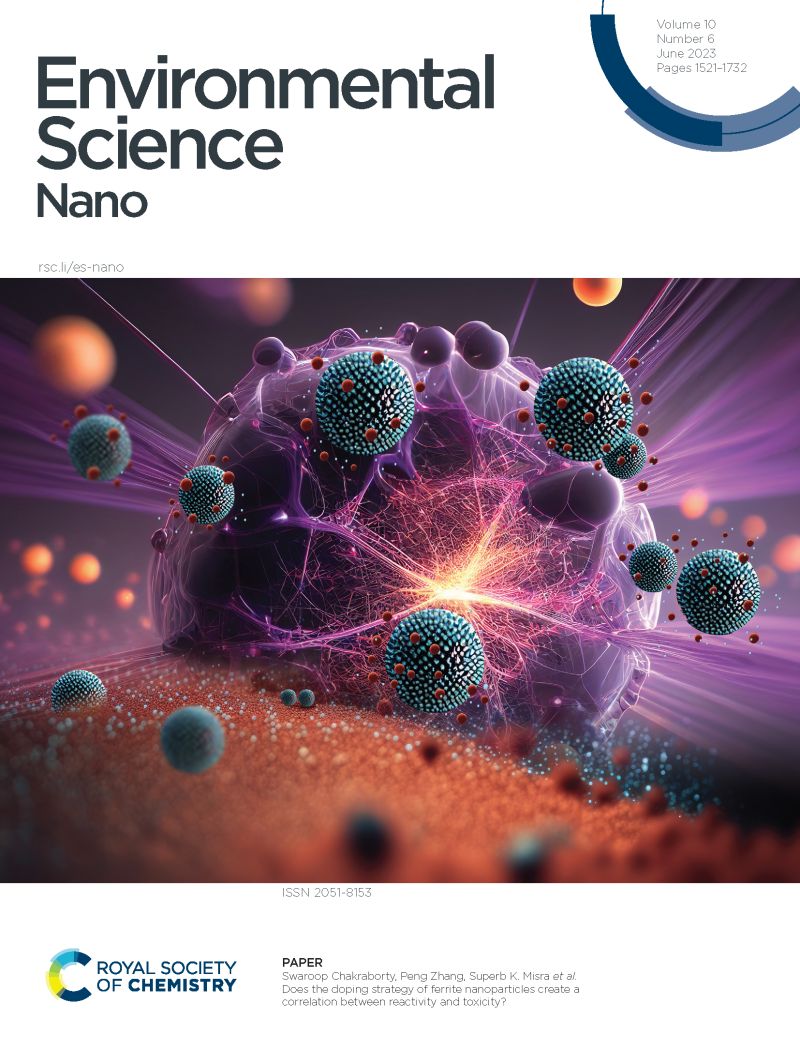通过分子动力学模拟揭示植酸在稳定氧化石墨烯纳米膜和实现油水分离的选择性渗透中的双重功能
IF 5.1
2区 环境科学与生态学
Q1 CHEMISTRY, MULTIDISCIPLINARY
引用次数: 0
摘要
植酸功能化氧化石墨烯(GO-PA)是一种很有前途的含油废水处理膜材料。然而,其结构参数对膜稳定性和油水分离性能的影响尚不清楚。本研究通过分子动力学模拟来阐明潜在的微观机制。结果表明,氧化石墨烯和PA自发组装成稳定的三明治状膜结构,其中高度氧化的层状氧化石墨烯框架增强了PA的容纳。PA通过致密的含氧官能团、亲和的相邻氧化石墨烯薄片牢固吸附在氧化石墨烯表面,精确控制层间间距,抑制氧化石墨烯自滚动。模拟进一步表明,氧化石墨烯氧覆盖率的降低加速了水的渗透,而增加PA的掺量显著提高了油水分离性能,水通量为4.1分子ns-1,分离效率为96.3%。能量分析表明,PA含量主导了膜的亲水性,对油渗透施加了比水更高的能量屏障。PA功能化大大提高了氧化石墨烯膜的油水分离能力,理论最大值达到97.5%的分离效率和98.8%的水纯度。这些发现证实了植酸在稳定氧化石墨烯纳米膜和促进水、油选择性渗透方面的双重作用。本研究得出的理论数据为宏观过程建模提供了重要的输入,并为在实际操作条件下合理设计材料和分离装置(如膜反应器)提供了工程应用基础。本文章由计算机程序翻译,如有差异,请以英文原文为准。
Uncovering the dual function of phytic acid in stabilizing graphene oxide nanomembranes and enabling selective permeation for oil-water separation by molecular dynamics simulations
Phytic acid functionalized graphene oxide (GO-PA) is a promising membrane material for oily wastewater treatment. However, the effects of its structural parameters on membrane stability and oil-water separation performance remains unclear. This study performed molecular dynamics simulations to elucidate the underlying microscopic mechanisms. Results revealed that GO and PA spontaneously assembled into a stable sandwich-like membrane structure, wherein a highly oxidized lamellar GO framework enhanced PA accommodation. PA adsorbed robustly onto the GO surface through dense oxygen-containing functional groups, cross-liking adjacent GO sheets to precisely control interlayer spacing and suppress GO self-scrolling. Simulations further revealed that reduced GO oxygen coverage accelerated water permeation, while increasing the PA mixing ratio significantly improved oil-water separation performance, yielding a water flux of 4.1 molecules ns-1 and a separation efficiency of 96.3%. Energy analysis demonstrated that PA content dominated membrane hydrophilicity, imposing higher energy barriers for oil permeation than water. PA functionalization substantially enhanced the oil-water separation capability of GO membrane, with theoretical maxima reaching 97.5% separation efficiency and 98.8% water purity. These findings confirmed the dual role of phytic acid in stabilizing GO nanomembranes and promoting selective permeation of water and oil. The theoretical data derived from this study offered critical input for macroscopic process modelling and provided a foundation for engineering applications through rational design of materials and separation units (e.g. membrane reactor) under realistic operating conditions.
求助全文
通过发布文献求助,成功后即可免费获取论文全文。
去求助
来源期刊

Environmental Science: Nano
CHEMISTRY, MULTIDISCIPLINARY-ENVIRONMENTAL SCIENCES
CiteScore
12.20
自引率
5.50%
发文量
290
审稿时长
2.1 months
期刊介绍:
Environmental Science: Nano serves as a comprehensive and high-impact peer-reviewed source of information on the design and demonstration of engineered nanomaterials for environment-based applications. It also covers the interactions between engineered, natural, and incidental nanomaterials with biological and environmental systems. This scope includes, but is not limited to, the following topic areas:
Novel nanomaterial-based applications for water, air, soil, food, and energy sustainability
Nanomaterial interactions with biological systems and nanotoxicology
Environmental fate, reactivity, and transformations of nanoscale materials
Nanoscale processes in the environment
Sustainable nanotechnology including rational nanomaterial design, life cycle assessment, risk/benefit analysis
 求助内容:
求助内容: 应助结果提醒方式:
应助结果提醒方式:


